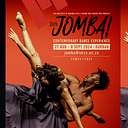“TIME MACHINE” in the “TIMELAPSE”
By Thembela Sibiya
JOMBA! Has done it again! Blessing the audience with two exceptional performance pieces, “Time Machine: Unveiling the Inner Strength” by Joseph Tebandeke from Uganda and “TIMELAPSE” by Unmute Dance Theatre from Cape Town, performed by Andile Vellem who is deaf, Nadine Mckenzie with her wheelchair and Yaseen Manuel. JOMBA! brought these two performances together for the “Danceability” festival focus, engaging the audience with tangible and intangible heritages on dance and disability. Both performances deconstruct and offer a challenging gaze on ‘who can dance’ and what is perceived as a dancing body.
Joseph Tebandeke’s “Time Machine” uses his body as a vocabulary telling a story of the relationship he has with his crutches and how getting to know his body’s limits helped him bond with each crutch he ever had. During the performance different types of crutches are suspended upstage and the other two are placed downstage to the left, the other to the right, perched on microphone stands.
The performance starts as Tebandeke is silently speaking to the crutch downstage left; it felt as if he was praying or it was his sacred place where he draws his strength from, his source of power. He moves around talking to the crutches and loses the other crutch he uses for support, falls and struggles to get up; he crawls, vibrates and shakes on the ground and lies down.
All light fades and leaves a long beam downstage facing Tebandeke on the other side. He starts to crawl and slithers like a snake towards the light using a silent scream and moves his legs with his hands, stretching and changing position. He starts to crawl in reverse moving away from the light still expressing the silent scream. He uses crutches to stand and dances touching all the crutches on stage, drops down and kneels in front of the crutch legs displayed almost like candles downstage to the left. It’s like an altar that he kneels at.
He points to the audience with his crutch, almost accusatory, and then he smashes it on stage, shattering it. This symbolises confrontation, on how society sees disability as something contagious and classifies disabled bodies as incapable and fragile. Tebandeke then starts picking up the pieces of the smashed crutch and tries to put it together with scraps of fabric, as if constructing his self-identity and objecting to what society sees as brokenness. He displays the re-constructed crutch with the other ones it spins as it hangs in space. He then performs with each of them, an intangible memory of how he had to bond with each new/used crutch he ever owned turned into a tangible performance. While telling this story of his journey, the sound of a clock is heard on the background and he moves his crutches in semi-circular movements indicating the essence of becoming; the journey he has been onwith his crutches and identity.
“TIMELAPSE” by Unmute Dance Theatre is about personal relationships from birth with the dancers’ bodies and with themselves; the connection the performers have created with one another, testing their body limits and abilities, building trust and taking risks.
The performance is centered around the colour “red” and screamed danger to me, or perhaps what is seen as dangerous. Centre stage a triangle is constructed with a red cloth and human figures are wrapped completely at the two ends like a baby in a womb. Andile Vellem performs dance in sign language giving life to the figures on stage. Nadine Mckenzie and Yaseen Manuel come out of the cloth rolling on the floor towards the lone wheelchair center stage to the right.
It seemed as if they were twins with the same identity. The three performers start to dance given cues by the lighting. Mckenzie and Manuel dance together giving each other support; there is a lot of physicality and Manuel and Vellem perform a duet with many falls and catches, at times there is conflict and Manuel repeatedly walks away from him.
Mckenzie then, helps Vellem up and dances with him. The duests become a trio again. The wheelchair is used as the part of the performance — tossing, turning, leaning, lifting, support and a lot of dangerous movements testing the limitations of their bodies. The clock sound is heard again in the background; the essence of time is shown through how their relationship journey in dance has tested their abilities and body limits, with the use of their bodies and fingers imitating the clock movement, while a voiceover discusses possibilities for creation. Vellem’s final solo in sign language spoke of togetherness, family, heart, love and the tenderness of a friendship forged through danceas the lights faded away.
